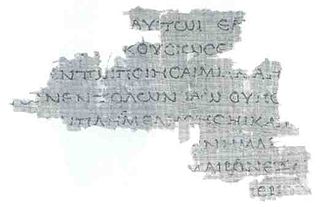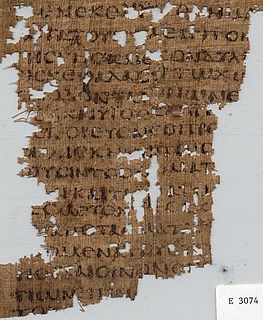 W
WThe Septuagint (LXX), the ancient Alexandrian translation of Jewish scriptures into Koine Greek exists in various manuscript versions.
 W
W4Q119 designates the remnants of a Greek manuscript of the Book of Leviticus written on parchment. It was found at Qumran cave 4 and is dated to the 1st century BCE or 1st century CE. It got the no. 801 according to the system of Alfred Rahlfs. The manuscript is stored in Rockefeller Museum at Jerusalem.
 W
WThe manuscript 4Q120 is a Septuagint manuscript (LXX) of the biblical Book of Leviticus, found at Qumran. The Rahlfs-No. is 802. Palaoegraphycally it dates from the first century BCE. Currently the manuscript is housed in the Rockefeller Museum in Jerusalem.
 W
W4Q122 – is a septuagint manuscript written on parchment, dated from second century B.C.E.. The scroll contains a fragment of the biblical Book of Deuteronomy 11:4. It was found in a cave at Qumran in Cave 4. This fragment is also referred to as number 819 on the list of the Septuagint manuscripts according classification system by Alfred Rahlfs.
 W
WThe Codex Alexandrinus is a fifth-century Christian manuscript of a Greek Bible, containing the majority of the Greek Old Testament and the Greek New Testament. It is one of the four Great uncial codices. Along with the Codex Sinaiticus and the Vaticanus, it is one of the earliest and most complete manuscripts of the Bible. Brian Walton assigned Alexandrinus the capital Latin letter A in the Polyglot Bible of 1657. This designation was maintained when the system was standardized by Wettstein in 1751. Thus, Alexandrinus held the first position in the manuscript list.
 W
WThe ms. Ambrosiano O 39 sup. – is a manuscript of the Hexapla of Origen dated to the late ninth century C.E. written in a codex form. This is a palimpsest. The manuscript is designated with the number 1098 in the list of the septuagint manuscripts as the classification of Alfred Rahlfs.
 W
WThe Bodmer Papyri are a group of twenty-two papyri discovered in Egypt in 1952. They are named after Martin Bodmer, who purchased them. The papyri contain segments from the Old and New Testaments, early Christian literature, Homer, and Menander. The oldest, P66 dates to c. 200 AD. Most of the papyri are kept at the Bibliotheca Bodmeriana, in Cologny, Switzerland outside Geneva.
 W
WChludov Psalter is an illuminated marginal Psalter made in the middle of the 9th Century. It is a unique monument of Byzantine art at the time of the Iconoclasm, one of only three illuminated Byzantine Psalters to survive from the 9th century.
 W
WCodex Ephraemi Rescriptus is a fifth-century Greek manuscript of the Bible, sometimes referred to as one of the four great uncials. The manuscript is not intact: in its current condition, Codex C contains material from every New Testament book except 2 Thessalonians and 2 John; however, only six books of the Greek Old Testament are represented. It is not known whether 2 Thessalonians and 2 John were excluded on purpose, or whether no fragment of either epistle happened to survive.
 W
WCodex Marchalianus designated by siglum Q is a 6th-century Greek manuscript copy of the Greek version of the Hebrew Bible known as the Septuagint. The text was written on vellum in uncial letters. Palaeographically it has been assigned to the 6th century. Marginal annotations were later added to the copy of the Scripture text, the early ones being of importance for a study of the history of the Septuagint.
 W
WCodex Sinaiticus or "Sinai Bible" is one of the four great uncial codices, ancient, handwritten copies of a Christian Bible in Greek. The codex is a historical treasure.
 W
WThe Codex Vaticanus is one of the oldest copies of the Bible, one of the four great uncial codices. The Codex is named after its place of conservation in the Vatican Library, where it has been kept since at least the 15th century. It is written on 759 leaves of vellum in uncial letters and has been dated palaeographically to the 4th century.
 W
WThe Cotton Genesis is a 4th- or 5th-century Greek Illuminated manuscript copy of the Book of Genesis. It was a luxury manuscript with many miniatures. It is one of the oldest illustrated biblical codices to survive to the modern period. Most of the manuscript was destroyed in the Cotton library fire in 1731, leaving only eighteen charred, shrunken scraps of vellum. From the remnants, the manuscript appears to have been more than 440 pages with approximately 340-360 illustrations that were framed and inserted into the text column. Many miniatures were also copied in the 17th century and are now in the Bibliothèque nationale de France in Paris.
 W
WThe Greek Minor Prophets Scroll from Nahal Hever is a Greek manuscript of a revision of the Septuagint dated to the 1st century CE. The manuscript is kept in the Rockefeller Museum in Jerusalem. It was first published by Dominique Barthélemy in 1963. The Rahlfs-Siglum is 943.
 W
WThe Joshua Roll is a Byzantine illuminated manuscript of highly unusual format, probably of the 10th century Macedonian Renaissance, believed to have been created by artists of the imperial workshops in Constantinople, and is now held in the Vatican Library.
 W
WCodex Sancti Simeonis contains a fragment of a Gospel lectionary, or Evangelistarion, designated by siglum ℓ 179 in the Gregory-Aland numbering; it is written on parchment and dated to the 10th century. The codex is housed in Trier.
 W
WLectionary 205, designated by siglum ℓ 205 is a Greek manuscript of the New Testament, on parchment. Palaeographically it has been assigned to the 10th century. Scrivener labelled it by 201evl. The manuscript has complex context.
 W
WLectionary 223, designated by siglum ℓ 223 is a Greek manuscript of the New Testament, on paper. Palaeographically it has been assigned to the 15th century. Frederick Henry Ambrose Scrivener labelled it by 252evl. It contains much additional material, liturgical and secular.
 W
WLectionary 226, designated by siglum ℓ 226 is a Greek manuscript of the New Testament, on parchment. Palaeographically it has been assigned to the 14th century. F. H. A. Scrivener labelled it by 249evl. Some leaves of the manuscript were lost, and some leaves have survived in a fragmentary condition.
 W
WLectionary 228, designated by siglum ℓ 228 is a Greek manuscript of the New Testament, on paper. Palaeographically it has been assigned to the 15th century. Frederick Henry Ambrose Scrivener labelled it by 253evl. Some leaves of the manuscript were lost.
 W
WMinuscule 57, δ 255, is a Greek minuscule manuscript of the New Testament, on parchment leaves. Palaeographically it has been assigned to the 12th century. The manuscript is lacunose. It has marginalia.
 W
WThe Papyrus LXX Oxyrhynchus 3522, – is a small fragment of the Greek Septuaginta (LXX) written in papyrus, in scroll form. As one of the manuscripts discovered at Oxyrhynchus it has been catalogued with the number 3522. Palaeographically it has been dated to the 1st century CE.
 W
WPapyrus 18, designated by 18, is an early copy of the New Testament in Greek. It is a papyrus manuscript containing the beginning of the Book of Revelation. It contains only Revelation 1:4–7. It is written against the fibres of the papyrus. On the other side of the papyrus is the ending of the book of Exodus. It is unclear whether the papyrus was a scroll of Exodus later reused for a copy of Revelation or a leaf from a codex with miscellaneous contents. The two sides of the papyrus were copied in different hands, but the original editor of the papyrus did not think there was a great interval of time between the copying of the two sides. He assigned the Exodus to the third century and the Revelation to the third or early fourth century.
 W
WPapyrus 967 is a 3rd-century biblical manuscript, discovered in 1931. It is notable for containing fragments of the original Septuagint text of the Book of Daniel, which was completely superseded by a revised text by the end of the 4th century and elsewhere survives only in Syriac translation and in Codex Chisianus 88. The manuscript is also important for early variants, both in the text of the Book of Ezekiel and of the Book of Daniel.
 W
WPapyrus Fouad 266 is a copy of the Pentateuch in the Greek version of the Hebrew Bible known as the Septuagint. It is a papyrus manuscript in scroll form. The manuscript has been assigned palaeographically to the 1st century BC. The manuscript has survived in a fragmentary condition. Discussion about this manuscript questions whether it is or is not a later recension of the standard Septuagint text.
 W
WPapyrus Oxyrhynchus 656 – is a Greek fragment of a Septuagint manuscript written on papyrus in codex form. This is a manuscript discovered at Oxyrhynchus, and it has been catalogued with number 656. Palaeographycally it is dated to late second century or early third century.
 W
WPapyrus Oxyrhynchus 846 is a 6th-century manuscript of a portion of the Greek version of the Hebrew Bible known as the Septuagint. It is one of the manuscripts discovered in Oxyrhynchus, was cataloged under the number 846. Palaeographically dates back to the sixth century CE. It contains Amos 2:6-12. The manuscript is formatted in a single column per page. It has been numbered as 906 in the list of Septuagint manuscripts according to classification by Alfreda Rahlfs.
 W
WPapyrus Oxyrhynchus 1007 is a fragment of a Septuagint manuscript (LXX) written in two columns on a parchment codex. The manuscript was discovered in Oxyrhynchus, modern El-Bahnasa, Egypt. The manuscript has been palaeographically dated to the 3rd century CE.
 W
WPapyrus Oxyrhynchus 5101, designated P.Oxy.LXXVII 5101 contains fragments of a manuscript in Koine Greek of the Septuagint (LXX), written on papyrus in roll form. It has been palaeographycally dated to have been written between 50 and 150 C.E.
 W
WPapyrus Rylands 458 is a copy of the Pentateuch in a Greek version of the Hebrew Bible known as the Septuagint. It is a papyrus manuscript in roll form. The manuscript has been assigned palaeographically toward the middle of the 2nd century BC, and before the discovery of the Dead Sea Scrolls it was the oldest known manuscript of the Greek Bible. The manuscript has survived in a very fragmentary condition.
 W
WThe Washington Manuscript of the Psalms is designated as Rahlfs 1219, and van Haelst 83 in the Van Haelst Catalogue numbers. The manuscript (MS) contains the text of Psalm 1:4-146:9a, 149:2b-151:6 in Greek, plus the first 6 verses of the book of Odes, written on parchment sometime in the 5th Century CE.
 W
WThe Vienna Genesis, designated by siglum L (Ralphs), is an illuminated manuscript, probably produced in Syria in the first half of the 6th Century. It is the oldest well-preserved, surviving, illustrated biblical codex.